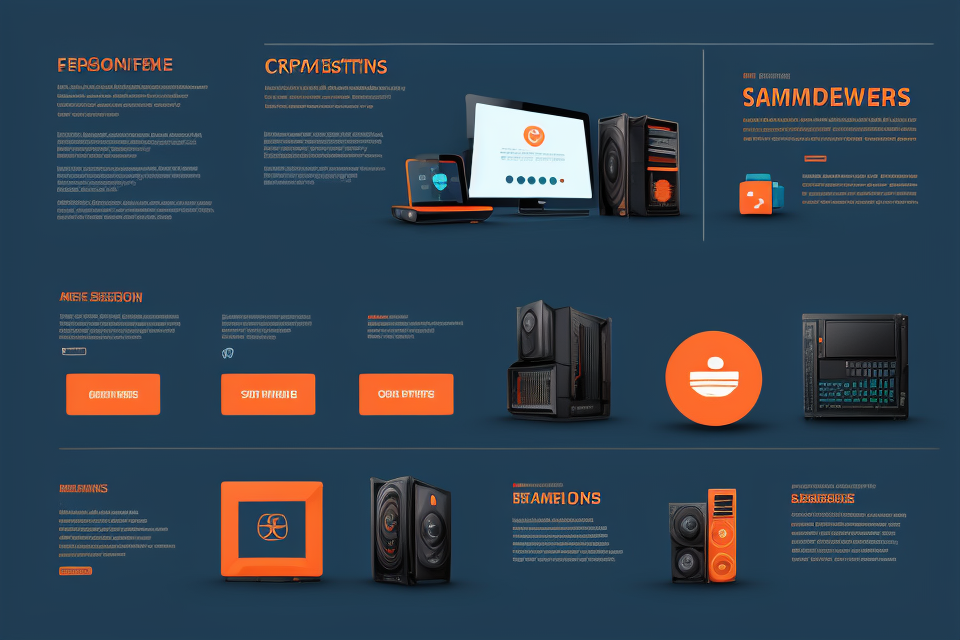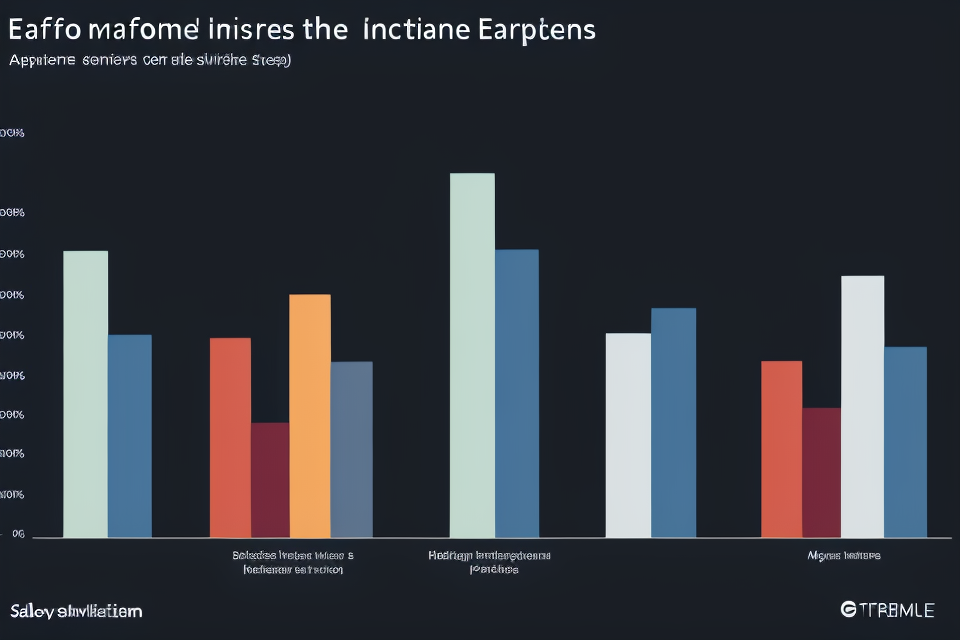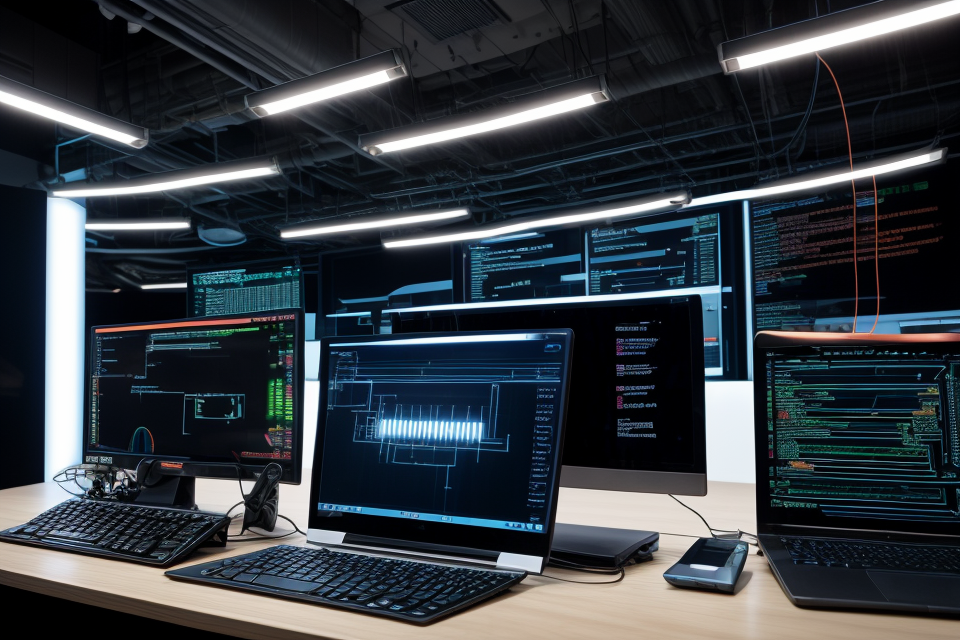
The relationship between hardware and software is a crucial one in the world of technology. Some believe that hardware and software are two separate entities that don’t work together, while others claim that they are inseparable. In this article, we will explore the truth behind this topic and separate fact from fiction. The answer may surprise you! So, let’s dive in to find out if hardware and software truly work together or not.
Understanding the Relationship Between Hardware and Software
The Role of Hardware in Running Software
When it comes to running software, hardware plays a crucial role in determining the overall performance and user experience. In this section, we will delve into the intricate relationship between hardware and software, and how different hardware components can affect the way software runs.
- How hardware components affect software performance
- Processor speed: The speed of the processor, also known as the clock speed, can significantly impact the performance of software. This is because the processor is responsible for executing instructions and performing calculations. Therefore, a faster processor can lead to smoother software performance and quicker response times.
- RAM: Random Access Memory (RAM) is a type of computer memory that can be accessed randomly, allowing data to be read and written in any order. The amount of RAM available can affect the performance of software, especially if the software requires a lot of data to be processed at once.
- Graphics Card: The graphics card is responsible for rendering images and video, and it can significantly impact the performance of software that relies heavily on graphics, such as video editing software or video games.
- The importance of hardware compatibility with software
- Software developers often design their programs to work with specific hardware components, such as a particular graphics card or sound card. This means that if a user tries to run software on hardware that is not compatible, the software may not function properly or may not work at all.
- In addition, hardware upgrades can also affect software performance. For example, if a user upgrades their graphics card, they may notice a significant improvement in the performance of software that relies heavily on graphics.
- Compatibility issues can also arise when using virtual machines or emulators, which allow users to run software on hardware that is not native to the software. For example, a user may try to run a program designed for Windows on a Mac using a virtual machine, but this may result in compatibility issues that can affect the performance of the software.
The Role of Software in Controlling Hardware
In the world of technology, hardware and software are often seen as two separate entities that work together to create a functioning computer system. However, it is important to understand the role that software plays in controlling hardware.
- How software interacts with hardware components
Software is the set of instructions that tell the computer what to do. It is the software that tells the computer to read data from the hard drive, display it on the screen, and respond to user input. Without software, the hardware components of a computer would be useless. - The impact of software on hardware performance
The performance of a computer is determined by both the hardware and software components. Software can have a significant impact on the performance of hardware components. For example, a program that is poorly written can cause a computer to run slowly, even if the hardware is powerful. On the other hand, a well-written program can make the most of the hardware, improving performance.
In conclusion, software and hardware are intimately connected and cannot be considered separately. The software is what makes the hardware work, and the hardware is what allows the software to run. A proper understanding of the relationship between hardware and software is crucial for anyone working in the technology industry.
The Truth About Hardware and Software Working Together
Hardware and software are intricately connected and rely on each other to function properly. Hardware components such as the processor speed, RAM, and graphics card can significantly impact the performance of software. Software interacts with hardware components and can have a significant impact on the performance of hardware components. Therefore, it is essential to understand the interdependence of hardware and software and to ensure that they are properly integrated to achieve optimal performance.
Hardware and Software are Interdependent
Hardware and software are intricately connected and rely on each other to function effectively. It is essential to understand this interdependence to comprehend how technology works and to design, develop, and maintain systems that meet users’ needs.
The Interconnectedness of Hardware and Software
Hardware and software are interconnected in a way that they complement each other. Hardware provides the physical structure that runs software, while software provides the instructions that tell the hardware what to do. In other words, hardware and software are like two sides of the same coin, and they work together to achieve a common goal.
For example, a computer’s CPU (central processing unit) and memory are hardware components that work together to execute software instructions. The CPU is responsible for executing the instructions, while the memory stores the data and instructions that the CPU needs to complete its tasks. Without both hardware components, the software cannot run correctly.
The Need for Both Hardware and Software to Function Together
Hardware and software are equally important and necessary for a system to function correctly. Neither hardware nor software can function independently of the other. If either the hardware or software is missing or not functioning correctly, the system will not work as intended.
For instance, a smartphone requires both hardware (e.g., the processor, memory, and storage) and software (e.g., the operating system, apps, and updates) to function correctly. Without the hardware, the software cannot run, and without the software, the hardware is useless.
Therefore, it is crucial to understand the interdependence of hardware and software when designing, developing, and maintaining technology systems. By recognizing this interdependence, developers can create systems that are efficient, reliable, and user-friendly.
Myths and Misconceptions About Hardware and Software
One of the most prevalent misconceptions about hardware and software is the idea that they are separate entities that do not work together. This notion stems from the belief that hardware is simply a physical component that exists independently of software, and that software is merely a set of instructions that run on the hardware.
However, this view is far from the truth. In reality, hardware and software are intricately linked and depend on each other to function properly. Without the right hardware, software cannot run effectively, and without the right software, hardware is rendered useless.
Another common misconception is the belief that hardware is more important than software or vice versa. This idea is often perpetuated by those who do not fully understand the inner workings of technology. In reality, both hardware and software are equally important and cannot function without each other.
It is important to understand that hardware and software are not simply separate components that happen to work together. Instead, they are intimately connected and rely on each other to function properly. Therefore, it is essential to recognize the interdependence of hardware and software and to ensure that they are properly integrated in order to achieve optimal performance.
Factors Affecting the Interaction Between Hardware and Software
Hardware Compatibility
When it comes to the interaction between hardware and software, hardware compatibility is a crucial factor that cannot be overlooked. Hardware compatibility refers to the ability of different hardware components to work together seamlessly with software programs.
The importance of hardware compatibility with different software cannot be overstated. When hardware and software are not compatible, it can lead to a host of problems, including system crashes, errors, and even hardware damage. Therefore, it is essential to ensure that all hardware components are compatible with the software being used.
However, hardware compatibility issues can arise, and when they do, it is important to know how to resolve them. One solution is to ensure that all hardware components are up to date and have the latest drivers and firmware installed. Additionally, checking for software compatibility with the operating system and other software programs can help to resolve hardware compatibility issues.
Another solution is to seek help from the manufacturer or technical support team. They can provide guidance on how to resolve hardware compatibility issues and may even provide updated drivers or firmware to resolve the problem.
In conclusion, hardware compatibility is a critical factor that affects the interaction between hardware and software. By ensuring that all hardware components are compatible with the software being used, and by seeking help from manufacturers or technical support teams when compatibility issues arise, users can avoid system crashes, errors, and hardware damage.
Software Compatibility
Software compatibility is a critical factor that affects the interaction between hardware and software. It refers to the ability of software to work effectively with different hardware configurations. The compatibility of software with hardware is crucial because it determines the smooth operation of the system.
Software compatibility issues can arise due to various reasons, such as differences in hardware architecture, operating system, or peripheral devices. For instance, a software application designed for a specific operating system may not work correctly on another operating system, leading to compatibility issues. Similarly, a peripheral device that is not compatible with the software or hardware can cause problems.
However, software compatibility issues can be resolved by taking certain measures. One approach is to ensure that the software is designed to be compatible with multiple hardware configurations. This involves designing the software to be flexible and adaptable to different hardware environments. Another approach is to ensure that the hardware is compatible with the software. This involves selecting hardware that is compatible with the software and ensuring that it is properly configured.
Additionally, some software applications have built-in compatibility modes that allow them to work with different hardware configurations. These compatibility modes can be activated to resolve software compatibility issues. Furthermore, manufacturers of hardware and software often provide technical support and troubleshooting guides to help users resolve compatibility issues.
In conclusion, software compatibility is a critical factor that affects the interaction between hardware and software. It is essential to ensure that software is designed to be compatible with multiple hardware configurations and that hardware is compatible with the software. Additionally, software manufacturers provide technical support and troubleshooting guides to help users resolve compatibility issues.
Other Factors Affecting the Interaction Between Hardware and Software
In addition to the factors already discussed, there are other factors that can affect the interaction between hardware and software. These include:
- Operating systems and their impact on hardware and software compatibility: The operating system is the software that manages the hardware and software resources of a computer. Different operating systems have different requirements for hardware and software, and incompatible combinations can lead to problems. For example, an older computer with limited resources may not be able to run the latest version of an operating system, which could impact the compatibility of the hardware and software installed on the computer.
- Updates and upgrades and their effects on hardware and software: Updates and upgrades to software and hardware can also impact their compatibility. For example, a software update may require a newer version of an operating system, which may not be compatible with older hardware. Similarly, upgrading the hardware of a computer may require updates to the software to ensure compatibility. It is important to carefully consider the compatibility of hardware and software when making updates or upgrades to a computer system.
The Future of Hardware and Software Working Together
Advancements in Hardware and Software Technology
As technology continues to advance, it is important to understand the impact of these advancements on the relationship between hardware and software. Here are some key areas where hardware and software are working together to drive innovation:
- Artificial Intelligence and Machine Learning
- The integration of AI and ML into hardware devices is increasing, enabling them to perform more complex tasks and make intelligent decisions based on data collected from sensors and other sources.
- This integration requires close collaboration between hardware and software developers to ensure that the hardware is optimized for the specific requirements of AI and ML algorithms.
- Internet of Things (IoT)
- The IoT is a network of connected devices that can communicate with each other and exchange data.
- Hardware and software must work together to ensure that these devices can exchange data seamlessly and securely, and that the data is analyzed and used to drive business outcomes.
- Quantum Computing
- Quantum computing is a new area of hardware technology that has the potential to revolutionize computing as we know it.
- Software developers must work closely with hardware engineers to ensure that the software is optimized for the unique requirements of quantum computing, such as the need for highly specialized programming languages and the requirement for low-level programming.
- Edge Computing
- Edge computing is a distributed computing architecture that enables data to be processed closer to the source, rather than being sent to a centralized data center.
- This requires hardware and software to work together to ensure that the data is processed efficiently and securely, and that it is analyzed in real-time to drive business outcomes.
Overall, the relationship between hardware and software is becoming increasingly important as technology continues to evolve. To ensure that hardware and software work together effectively, developers must collaborate closely and stay up-to-date with the latest advancements in both areas.
The Importance of Compatibility in the Future
The Importance of Hardware and Software Compatibility in the Future
As technology continues to advance at a rapid pace, the relationship between hardware and software becomes increasingly important. In the future, hardware and software compatibility will be crucial for ensuring seamless integration and operation of devices and systems.
One of the main reasons why compatibility is so important is that it allows users to take advantage of the latest technological advancements without having to replace their existing hardware or software. For example, if a user has invested in a high-end computer system, they will want to be able to use the latest software programs and applications without encountering any compatibility issues.
Another reason why compatibility is important is that it allows for the development of more complex and sophisticated systems. As hardware and software become more integrated, it becomes possible to create systems that are capable of performing more advanced tasks and functions. This can lead to significant improvements in efficiency, productivity, and overall performance.
How Advancements in Technology Will Affect Compatibility Between Hardware and Software
As technology continues to evolve, it is likely that we will see a greater emphasis on hardware and software compatibility. This is because new technologies and systems will be designed to work together seamlessly, without the need for compatibility issues to be addressed.
For example, the development of 5G networks is likely to have a significant impact on hardware and software compatibility. As these networks become more widespread, they will enable the development of new devices and systems that are designed to work together seamlessly. This will require hardware and software manufacturers to ensure that their products are compatible with these new networks, in order to take advantage of their advanced capabilities.
Overall, the importance of hardware and software compatibility in the future cannot be overstated. As technology continues to advance, it will become increasingly important for manufacturers to ensure that their products are compatible with one another, in order to provide users with the best possible experience.
FAQs
1. Do hardware and software work together?
Hardware and software are two essential components of a computer system, and they work together to enable the computer to function properly. Hardware refers to the physical components of a computer, such as the processor, memory, and storage devices. Software, on the other hand, refers to the programs and applications that run on the computer. In order for software to run, it needs to be installed on the computer, and the hardware must be capable of supporting it. Therefore, hardware and software work together to make a computer system function.
2. Is it true that hardware and software are incompatible?
It is not true that hardware and software are always incompatible. In fact, most modern hardware and software are designed to work together seamlessly. However, there may be instances where compatibility issues arise, particularly when using older hardware or software. In such cases, compatibility issues can often be resolved by updating the hardware or software or by using compatible devices or programs.
3. Can hardware be upgraded without affecting software?
It is generally not possible to upgrade hardware without affecting software. When a hardware component is upgraded, it may require new software to be installed or existing software to be updated to take advantage of the new hardware capabilities. For example, if a user upgrades their graphics card, they may need to install new graphics drivers or update their operating system to ensure compatibility with the new hardware.
4. Is it true that software can be used on any hardware?
It is not true that software can be used on any hardware. Software is designed to work with specific hardware configurations, and some software may not be compatible with certain hardware components. For example, a software program may require a specific type of graphics card or processor to run properly. Therefore, it is important to ensure that the hardware and software are compatible before installing new software on a computer system.


